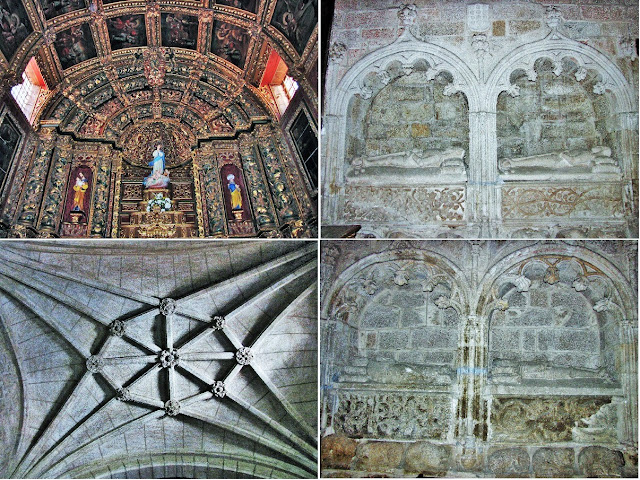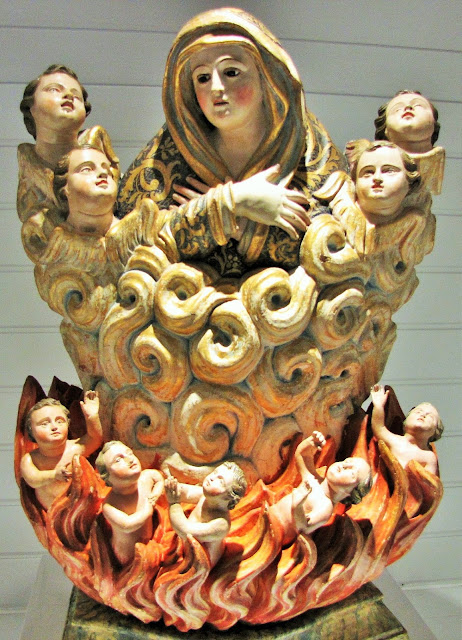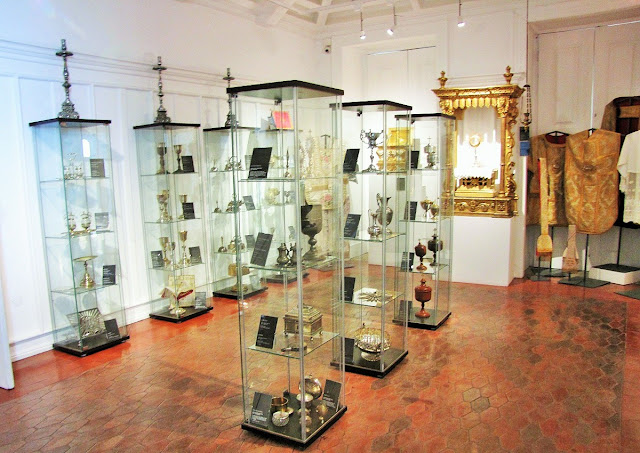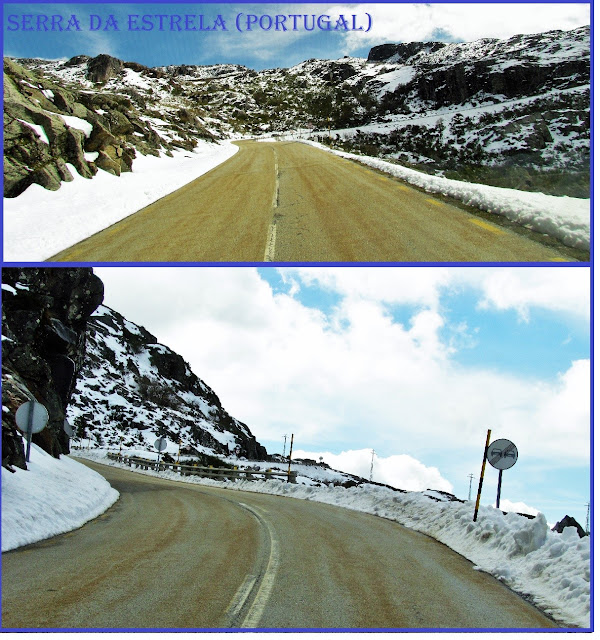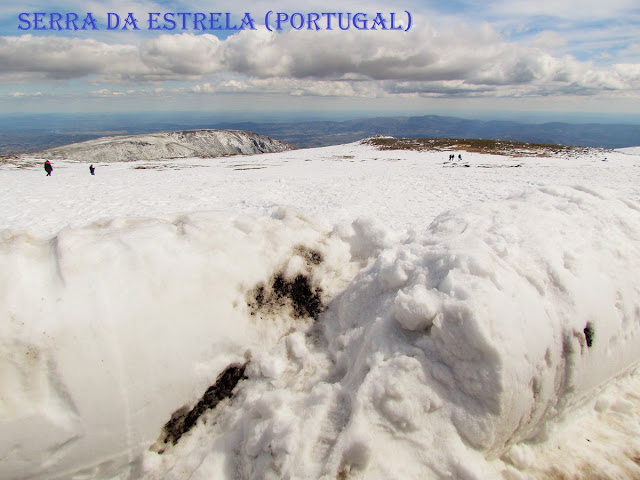COVILHÃ
N 40º 16' 48''; W 7º 30' 00''
Covilhã is a city and a municipality in the Centro region, Portugal. The city proper had 33,691 inhabitants in 2021. The municipality population in 2021 was 46,455 in an area of 555.60 square kilometers (214.52 sq mi). It is located in the Beiras e Serra da Estrela subregion and Beiras and Serra da Estrela Intermunicipal Community. The municipal holiday is October 20. Sometimes referred to as a town of wool and snow, Covilhã is one of the main urban centers of the historical Beira Interior region. The proximity of the mountains offers dramatic scenery and a great environment for those fond of hiking, camping, mountain climbing, and skiing. With an industrial tradition historically focused on the textile industry supplied by an abundance of wool produced in the area since antiquity, but with a more diversified industry in contemporaneity, Covilhã, which was once known as the "Portuguese Manchester", is also a university city nowadays awarding degrees from aeronautical engineering to medicine to philosophy.
History
Covilhã's history dates back to the days when it was a pre-historical settlement, a shelter for Lusitanian shepherds, and a Roman fortress known as Cava Juliana or Silia Hermínia. The region of Beira Interior, where the city of Covilhã is located, is rich in historical places. Due to its strategic potential, its mountains were used to build castles for both attack and defence purposes. Covilhã was granted foral in 1186 by king Sancho I of Portugal, who also built the castle walls. And, later, it was king Denis of Portugal who ordered the construction of the walls of the admirable medieval district of Portas do Sol. The old quarters of the city have narrow cobblestone streets; pedestrians are challenged permanently by the ups and downs of most of the streets in the city.
It was already in the Middle Ages one of the main "villages of the kingdom", a situation later confirmed by the fact that great natives from the city or its surroundings became decisive in all the great Portuguese Discoveries of the 15th and 16th centuries: the advance in the Atlantic Ocean, the sea route to India, the discoveries of America and Brazil, the first circumnavigation of the Earth. In full population expansion when the Renaissance appeared, the economic sector was particularly important in agriculture, pastoralism, fruit-growing, and forestry. Trade and industry were booming. Gil Vicente cites "the many fine cloths". The Infante D. Henrique, knowing this reality well, became "lord" of Covilhã. The Portuguese Discoveries required large sums of money. The people of the town and its council collaborated not only through taxes, but also with their capital and talent.
The expansion overseas started with the conquest of Ceuta in 1415. Covilhã personalities such as Frei Diogo Alves da Cunha, who is buried in the Church of Conceição, participated in the event. The presence of ‘’covilhanenses’’ in the whole process extends with Pêro da Covilhã (first Portuguese to set foot on land in Mozambique and who sent news to D. João II on how to reach the places where the spices were produced, preparing the Maritime Way to India), João Ramalho, Fernão Penteado and others.
Among the missionaries we find Francisco Álvares, killed on the way to Brazil; Pêro da Covilhã, chaplain in Vasco da Gama’s expedition to India, the first martyr of India; Father Francisco Cabral, missionary in Japan; Father Gaspar Pais, who left Goa for Abyssinia; and many others who took, along with their faith, the name of Covilhã and Fundão in Cova da Beira valley to all parts of the world. The brothers Rui Faleiro and Francisco Faleiro, cosmographers, became notable for their knowledge of nautical science. During renaissance is Friar Heitor Pinto, one of the first Portuguese to publicly defend the Portuguese identity. His literary work is expressed in the classic "Image of Christian Life".
The importance of Covilhã, in this period, is explained not only by the "notable" title granted to it by king D. Sebastião but also by the works carried out here and in the region by the Castilian kings during the time of the Iberian Union. The Town Hall Square was indeed until the end of the 20th century, of Spanish Philippine style. In the surrounding streets one can find several traces of this style. In the municipality as well. Examples of the Manueline style can also be found in the city. This is the case of a Manueline window in the Jewish quarter in Rua das Flores. The architect Mateus Fernandes, from Covilhã, who designed the entrance door to the Imperfect Chapels in the Monastery of Batalha is also other notable personality from Covilhã.
Parishes
Administratively, the municipality is divided into 21 civil parishes (freguesias):
Aldeia de São Francisco de Assis
Barco e Coutada
Boidobra
Cantar-Galo e Vila do Carvalho
Casegas e Ourondo
Cortes do Meio
Covilhã e Canhoso
Dominguizo
Erada
Ferro
Orjais
Paul
Peraboa
Peso e Vales do Rio
São Jorge da Beira
Sobral de São Miguel
Teixoso e Sarzedo
Tortosendo
Unhais da Serra
Vale Formoso e Aldeia do Souto
Verdelhos
Economy
Major economic activities in the region include textiles, food production, agriculture, tourism and mining. The Panasqueira mines in the municipality of Covilhã, located over 30 kilometers to southwest of the city, is a large tin-tungsten mine made up of multiple concessions that started production in 1898. The industrial mining center commonly known as Panasqueira Mines extends over a vast area covered by the Panasqueira and Vale da Ermida Mining Fields with a total area around 20.5 km2. There is an estimated 12,000 km of tunnels, some still working and others already abandoned. At the time of World War II, about 10,000 people worked in the mine; by 2017, approximately 370. The mine had a planned production for more than 30 years as of 2017. The University of Beira Interior, established in 1979, has great importance in the city today. The Centro Hospitalar Universitário Cova da Beira at Covilhã, a state-run university hospital, plays a major role in the region. Covilhã is traditionally a center of wool and textile industries - the university's central building was the Royal Textile Factory, established by the Marquis of Pombal in the 18th century. Covilhã has deep industrial roots and is still one of the biggest woolen fabric producers in Europe.
The textile industry produces about 40,000 km of fabric per year, mainly through companies like Paulo de Oliveira, Penteadora, Tessimax, and A. Saraiva, which supply large worldwide textile and fashion brands such as Hugo Boss, Armani, Zegna, Marks & Spencer, Yves St. Laurent, Calvin Klein and Christian Dior.
Tourism is also important, and the city serves as a winter and mountain resort. Fruit production is important in the region of Cova da Beira, a subregion centered in Covilhã's municipality. Frulact, a Portuguese fruit processing company, has major industrial facilities in the municipality of Covilhã.
The city has a science park, Parkurbis, which has attracted several new businesses to the area. There is a large shopping center in Covilhã, Serra Shopping, and besides a wide variety of shops, it has a hypermarket, four cinemas and many restaurants. Hypermarkets and supermarkets located in the lower part of the town include Continente (inside Serra Shopping), Intermarché, Pingo Doce, and Lidl. The Public Market (Mercado Municipal) is another option and an opportunity to buy fresh produce directly from the producers. Covilhã hosts one of the biggest data centers in Europe, with the capacity to store 30 petabytes of information at onset. The building, which belongs to Altice, opened in September 2013 and has a floor area the size of 13 football pitches.
Transport
The nearest airports are located in Lisbon and Porto. From these two cities, Covilhã can be very easily reached both by train and bus. The railway and bus stations of Covilhã are within walking distance from one to the other (10 minutes walk). It is also possible to reach Covilhã directly by bus from abroad.
Covilhã is located less than 300 km from Lisbon and Porto, the two biggest cities in Portugal, and just 400 km from the Spanish capital, Madrid. Several national and international bus routes pass Covilhã, so it is easy and practical to reach almost all destinations. To reach Lisbon takes 3.5-4 hours by bus or by train. The bus station is situated in the lower part of the city; and the railway station is nearby, no more than 10 minute's walk. The railway company, CP (Caminhos de Ferro Portugueses), offers various types of services. An InterCity (Intercidades) train is recommended to reach Covilhã. There are also car rental companies in the city.
From Covilhã northwards to Guarda trains were operated by diesel motorcars. This scenic stretch of mountainous rural line provides the strategic last leg of the Beira Baixa Railway linking it to Guarda via Belmonte. However, for twelve years it was closed for modernization and electrification. The works, originally due for completion in 2011, were finally completed permitting the reopening of the 46 km line to Guarda in May 2021 after serious funding issues due to the weakness of the Portuguese economy.
A bus network – Transportes Urbanos da Covilhã – covers the entire urban area as well as the outskirts of the city, making it easy to travel both within and outside the city limits, although the buses are infrequent (not less than 1 hour between buses). Several bus lines serve university buildings. Cabs are also an option. They are painted cream (mostly black these days) and sometimes have a roof-light to identify them. In town they use taximeters, but once outside urban boundaries, the service is charged per km.
Covilhã's history dates back to the days when it was a pre-historical settlement, a shelter for Lusitanian shepherds, and a Roman fortress known as Cava Juliana or Silia Hermínia. The region of Beira Interior, where the city of Covilhã is located, is rich in historical places. Due to its strategic potential, its mountains were used to build castles for both attack and defence purposes. Covilhã was granted foral in 1186 by king Sancho I of Portugal, who also built the castle walls. And, later, it was king Denis of Portugal who ordered the construction of the walls of the admirable medieval district of Portas do Sol. The old quarters of the city have narrow cobblestone streets; pedestrians are challenged permanently by the ups and downs of most of the streets in the city.
It was already in the Middle Ages one of the main "villages of the kingdom", a situation later confirmed by the fact that great natives from the city or its surroundings became decisive in all the great Portuguese Discoveries of the 15th and 16th centuries: the advance in the Atlantic Ocean, the sea route to India, the discoveries of America and Brazil, the first circumnavigation of the Earth. In full population expansion when the Renaissance appeared, the economic sector was particularly important in agriculture, pastoralism, fruit-growing, and forestry. Trade and industry were booming. Gil Vicente cites "the many fine cloths". The Infante D. Henrique, knowing this reality well, became "lord" of Covilhã. The Portuguese Discoveries required large sums of money. The people of the town and its council collaborated not only through taxes, but also with their capital and talent.
The expansion overseas started with the conquest of Ceuta in 1415. Covilhã personalities such as Frei Diogo Alves da Cunha, who is buried in the Church of Conceição, participated in the event. The presence of ‘’covilhanenses’’ in the whole process extends with Pêro da Covilhã (first Portuguese to set foot on land in Mozambique and who sent news to D. João II on how to reach the places where the spices were produced, preparing the Maritime Way to India), João Ramalho, Fernão Penteado and others.
Among the missionaries we find Francisco Álvares, killed on the way to Brazil; Pêro da Covilhã, chaplain in Vasco da Gama’s expedition to India, the first martyr of India; Father Francisco Cabral, missionary in Japan; Father Gaspar Pais, who left Goa for Abyssinia; and many others who took, along with their faith, the name of Covilhã and Fundão in Cova da Beira valley to all parts of the world. The brothers Rui Faleiro and Francisco Faleiro, cosmographers, became notable for their knowledge of nautical science. During renaissance is Friar Heitor Pinto, one of the first Portuguese to publicly defend the Portuguese identity. His literary work is expressed in the classic "Image of Christian Life".
The importance of Covilhã, in this period, is explained not only by the "notable" title granted to it by king D. Sebastião but also by the works carried out here and in the region by the Castilian kings during the time of the Iberian Union. The Town Hall Square was indeed until the end of the 20th century, of Spanish Philippine style. In the surrounding streets one can find several traces of this style. In the municipality as well. Examples of the Manueline style can also be found in the city. This is the case of a Manueline window in the Jewish quarter in Rua das Flores. The architect Mateus Fernandes, from Covilhã, who designed the entrance door to the Imperfect Chapels in the Monastery of Batalha is also other notable personality from Covilhã.
Parishes
Administratively, the municipality is divided into 21 civil parishes (freguesias):
Aldeia de São Francisco de Assis
Barco e Coutada
Boidobra
Cantar-Galo e Vila do Carvalho
Casegas e Ourondo
Cortes do Meio
Covilhã e Canhoso
Dominguizo
Erada
Ferro
Orjais
Paul
Peraboa
Peso e Vales do Rio
São Jorge da Beira
Sobral de São Miguel
Teixoso e Sarzedo
Tortosendo
Unhais da Serra
Vale Formoso e Aldeia do Souto
Verdelhos
Economy
Major economic activities in the region include textiles, food production, agriculture, tourism and mining. The Panasqueira mines in the municipality of Covilhã, located over 30 kilometers to southwest of the city, is a large tin-tungsten mine made up of multiple concessions that started production in 1898. The industrial mining center commonly known as Panasqueira Mines extends over a vast area covered by the Panasqueira and Vale da Ermida Mining Fields with a total area around 20.5 km2. There is an estimated 12,000 km of tunnels, some still working and others already abandoned. At the time of World War II, about 10,000 people worked in the mine; by 2017, approximately 370. The mine had a planned production for more than 30 years as of 2017. The University of Beira Interior, established in 1979, has great importance in the city today. The Centro Hospitalar Universitário Cova da Beira at Covilhã, a state-run university hospital, plays a major role in the region. Covilhã is traditionally a center of wool and textile industries - the university's central building was the Royal Textile Factory, established by the Marquis of Pombal in the 18th century. Covilhã has deep industrial roots and is still one of the biggest woolen fabric producers in Europe.
The textile industry produces about 40,000 km of fabric per year, mainly through companies like Paulo de Oliveira, Penteadora, Tessimax, and A. Saraiva, which supply large worldwide textile and fashion brands such as Hugo Boss, Armani, Zegna, Marks & Spencer, Yves St. Laurent, Calvin Klein and Christian Dior.
Tourism is also important, and the city serves as a winter and mountain resort. Fruit production is important in the region of Cova da Beira, a subregion centered in Covilhã's municipality. Frulact, a Portuguese fruit processing company, has major industrial facilities in the municipality of Covilhã.
The city has a science park, Parkurbis, which has attracted several new businesses to the area. There is a large shopping center in Covilhã, Serra Shopping, and besides a wide variety of shops, it has a hypermarket, four cinemas and many restaurants. Hypermarkets and supermarkets located in the lower part of the town include Continente (inside Serra Shopping), Intermarché, Pingo Doce, and Lidl. The Public Market (Mercado Municipal) is another option and an opportunity to buy fresh produce directly from the producers. Covilhã hosts one of the biggest data centers in Europe, with the capacity to store 30 petabytes of information at onset. The building, which belongs to Altice, opened in September 2013 and has a floor area the size of 13 football pitches.
Transport
The nearest airports are located in Lisbon and Porto. From these two cities, Covilhã can be very easily reached both by train and bus. The railway and bus stations of Covilhã are within walking distance from one to the other (10 minutes walk). It is also possible to reach Covilhã directly by bus from abroad.
Covilhã is located less than 300 km from Lisbon and Porto, the two biggest cities in Portugal, and just 400 km from the Spanish capital, Madrid. Several national and international bus routes pass Covilhã, so it is easy and practical to reach almost all destinations. To reach Lisbon takes 3.5-4 hours by bus or by train. The bus station is situated in the lower part of the city; and the railway station is nearby, no more than 10 minute's walk. The railway company, CP (Caminhos de Ferro Portugueses), offers various types of services. An InterCity (Intercidades) train is recommended to reach Covilhã. There are also car rental companies in the city.
From Covilhã northwards to Guarda trains were operated by diesel motorcars. This scenic stretch of mountainous rural line provides the strategic last leg of the Beira Baixa Railway linking it to Guarda via Belmonte. However, for twelve years it was closed for modernization and electrification. The works, originally due for completion in 2011, were finally completed permitting the reopening of the 46 km line to Guarda in May 2021 after serious funding issues due to the weakness of the Portuguese economy.
A bus network – Transportes Urbanos da Covilhã – covers the entire urban area as well as the outskirts of the city, making it easy to travel both within and outside the city limits, although the buses are infrequent (not less than 1 hour between buses). Several bus lines serve university buildings. Cabs are also an option. They are painted cream (mostly black these days) and sometimes have a roof-light to identify them. In town they use taximeters, but once outside urban boundaries, the service is charged per km.
SERRA DA ESTRELA
N 49º 19' 19''; W 7º 36' 46''
Serra da Estrela, located in the Centro region (Beiras Region), designates the mountain range where the highest altitudes of mainland Portugal are found. Its highest point, at 1993 meters high and called Torre, makes it the second-highest mountain in Portugal (only the Pico Mountain, in the Azores, surpasses it by 358 meters). It is part of the widest mountain range called the Central System, in the subsystem designated as Montejunto-Estrela mountain system, which develops in the southwest-northeast direction from the Montejunto mountain range, and its parent peak is the Pico de Almançor. Serra da Estrela is a landscape area integrated into the Serra da Estrela Natural Park, which after its constitution on July 16, 1976, was established as the largest protected area on Portuguese soil.
In addition to the snow, extraordinary fauna, and flora, the traveler is also attracted by the orography of colossal proportions (Cântaro Magro) as well as the human, cultural, historical, and gastronomic wealth of the region.
The Serra is also rich from a hydrological point of view, from this massif many water lines flows. Four rivers are born in Serra da Estrela: the Mondego River; the Zêzere River; - that 200 Km. downstream is a tributary of the Tagus River; the Rio Alva - which pays tribute to the River Mondego - and the River Alvôco, all of them born from the same mountain range. They benefit two of the three largest hydrographic basins in the country: Mondego and Tejo - and without realizing it, every day, the inhabitants of Lisbon and Coimbra enjoy and depend on the water from the Serra da Estrela.
Serra da Estrela is located mainly in the district of Guarda (85% of its area; 74 529.3 hectares), and also has a small area in the district of Castelo Branco (15% of the area; 13 762.4 hectares). This is a division designed based on the protected area from which urban areas are excluded. Considering only the mountain's orography, the area in Castelo Branco will be slightly smaller.
Serra da Estrela is part of the territory of six municipalities: Guarda, Manteigas, Gouveia, Seia, Celorico da Beira, and Covilhã, all located in the Guarda district except the last one, which belongs to the Castelo Branco district. The entire region - and its municipalities - have natural and scenic beauty, with great tourist, anthropological and historical interest.
Serra da Estrela reaches its maximum altitude - 1993 meters above sea level - near the Tower. This point is the limit of four parishes: São Pedro (Manteigas), Loriga (Seia), Alvoco da Serra (Seia), and Unhais da Serra (Covilhã). For this reason, the highest point in mainland Portugal is shared by the three municipalities to which these parishes belong: Manteigas, Seia, and Covilhã.
💓💓💓💓💓
SEARCH IN ALPHABETICAL ORDER
IN THE DISTRICT OF CASTELO BRANCO
💓💓💓💓💓
Return to mainland Portugal &
the Azores and Madeira islands













